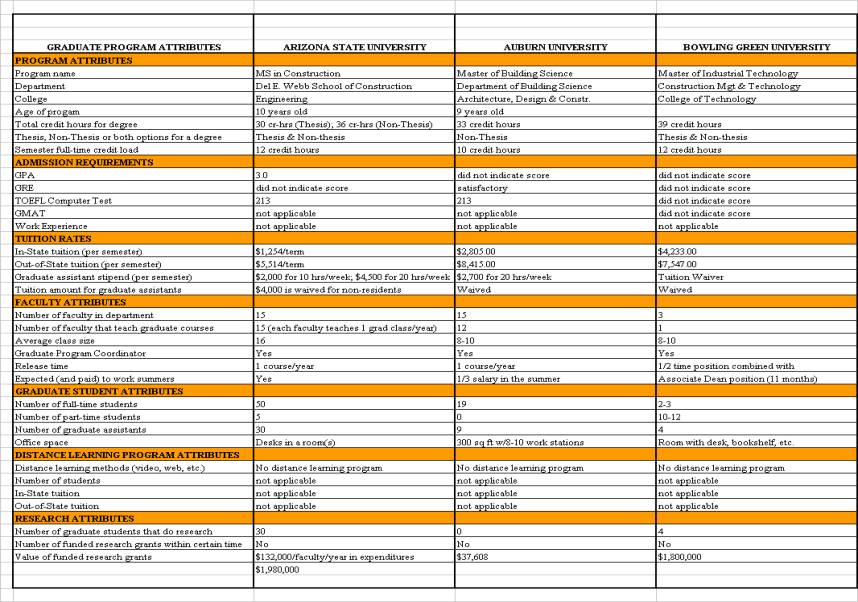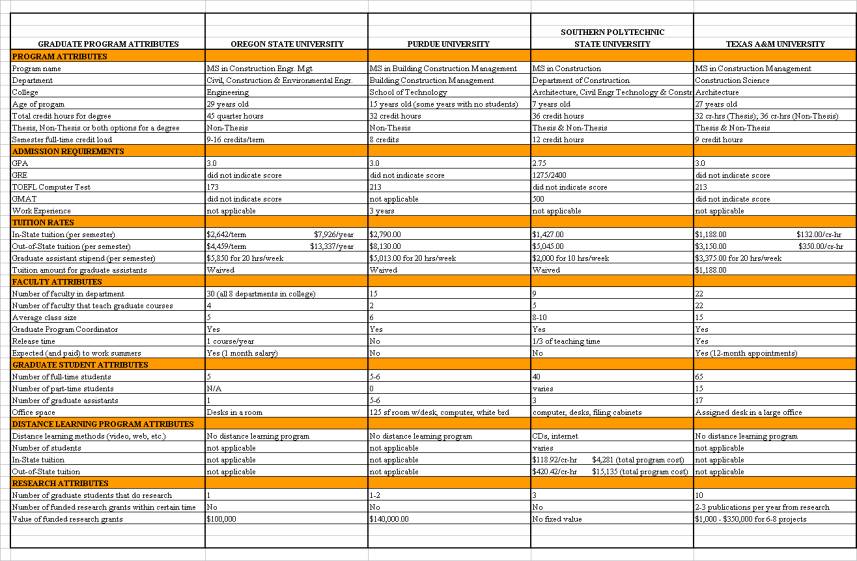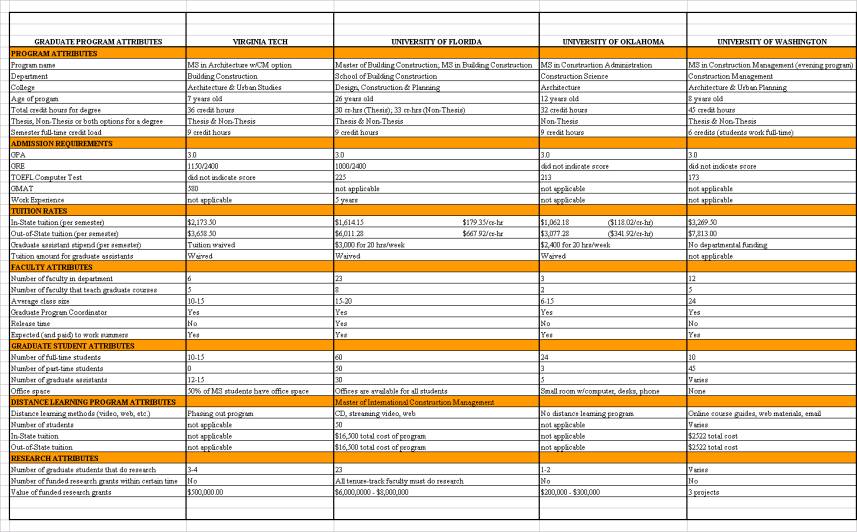- ASC Proceedings of the 39th Annual Conference
- Clemson University - Clemson, South Carolina
- April 8-12, 2003 pp 49-58
|
A Benchmark Study of Construction Master Degree Programs
|
|
During
the summer of 2002, a benchmarking study was conducted for the purpose
of comparing Clemson Universityís Master of Construction Science and
Management (MCSM) degree program with comparable masterís degree
programs at other universities. The
attributes used as a basis for comparison were program size, admission
requirements, graduate tuition rates, faculty size, graduate student
make-up, research, and the existence of a distance-learning program.
The findings will be used to assess the strengths and
weaknesses of Clemsonís MCSM degree program in comparison with other
construction science and management masterís degree programs.
Key
Words:
Graduate Education, Construction Education, Benchmark, Distance
Learning |
Clemson Universityís research-oriented goals during the next ten years are:
| Increase
research and sponsored programs to exceed $100 million a year in research
support. | |
| Improve
the national competitiveness of graduate student admissions and financial
aid. | |
| Increase
the annual number of doctoral graduates to the level of a top public
research university. | |
| Foster
Clemsonís academic reputation through strong academic programs,
mission-oriented research and academic centers of excellence, relevant
public service and highly regarded faculty and staff |
The
top research universities are highly competitive and are able to attract
top-notch graduate students. Therefore, the decision was made to conduct a
benchmarking study for the purpose of comparing Clemsonís MCSM degree
program with comparable master degree programs at other universities.
The masterís level was selected for benchmarking purposes because
Clemson does not have a doctoral program.
By looking at what the competition is doing, a graduate program can
assess its strengths and weaknesses and thereby focus its limited resources on
improvement in key areas of attracting and retaining quality graduate
students. Such key areas are
tuition rates, research opportunities, assistantship stipends and office space
availability.
A
survey of questions addressing key areas of attracting and retaining quality
graduate students was emailed to graduate coordinators or department chairs at
those universities with comparable masterís degree programs.
The following fifteen universities were included in the benchmark
study: Arizona State University, Auburn University, Bowling Green University,
Clemson University, Colorado State University, Florida International
University, Michigan State University, Oregon State University, Purdue
University, Southern Polytechnic State University, Texas A&M University,
Virginia Polytechnic State University, University of Florida, University of
Oklahoma, and University of Washington. This
list was based on those graduate programs in the United States recognized by
the American Council of Construction Education (ACCE).
The
survey assessed the following attributes and sub-attributes about the
masterís degree programs:
The
data was gathered from survey responses via email, websites of the various
universities, and through follow-up phone calls with the graduate coordinators
or department chairs. The results
were compiled in the spreadsheet format shown in the Appendix.
Results
The
following is a summary of key benchmark attributes by range and average for
the entire sample of all fifteen universitiesí masterís degree programs.
See the Appendix for specific information relative to any particular
institution.
Program
Attributes
All
fifteen universitiesí masterís degree programs range in age from seven to
thirty years with the average being sixteen years old.
Of the fourteen programs that offer a thesis and/or non-thesis option,
the total credit hours for the degree ranges from thirty to forty-five credit
hours with the average being thirty-six credit hours. The credit hours
represent a mix of quarter and semester hours.
Only Colorado State University requires the thesis option, which is
based on thirty total credit hours for the degree.
Admission
Requirements
The
vast majority of institutions require a minimum of a 3.0 undergraduate GPA.
Southern Polytechnic State University requires a 2.75 GPA and Auburn
University did not indicate any preferred score.
As
far as GRE scores, eight institutions did not indicate a minimum required
score; two universities indicate a satisfactory score; and the other five
universities range from a low of 1000 to a high of 1150 out of a possible 2400
with the average being 1155. With
the changes in GRE scoring made as of October 1, 2002, the universities will
need to determine new scores based on an aggregate of 1600 instead of 2400 for
the quantitative and analytical portions of the test as well as a new score
based on an aggregate of 6 for the newly instituted writing portion of the
test.
As
for the computer-based TOEFL (Test of English as a Foreign Language) test
scores, the range of minimum acceptable scores for twelve respondents is from
173 - 225 with the average being 210 for the computer-based test.
Bowling Green University, Southern Polytechnic State University and
Virginia Tech did not indicate a minimum TOEFL score.
Only
four universities indicate a work experience requirement that ranges from 1 -
5 years with the average being 3.5 years.
The majority of universities do not have a specific work experience
requirement.
Tuition
Rates
For
in-state (or resident) tuition, all fifteen programs range from $1,188 -
$4,233 per semester with an average of $2,226.
Out-of-state (or non-resident) tuition rates for all fifteen programs
range from $3,077 - $8,415 per semester with the average being $5,781.
This data is based on tuition rates for 2002-2003 as reported on the
various universitiesí web sites.
The
fifteen institutions vary widely on graduate assistantship stipends and work
hours per week. Four universities pay in the range of $1,600 - $2,430 ($2,008
average) for ten hours of work per week per semester. Nine universities pay in the range of $2,400 - $5,850 ($4,022
average) for twenty hours of work per week per semester.
Michigan Stateís stipend depends on the value of research projects in
the department. The University of
Washington offers no departmental stipends and Bowling Green University and
Virginia Tech waive tuition in lieu of providing stipends.
The
majority of the respondents indicated that tuition is waived for in-state and
out-of-state graduate assistants. Only
Arizona State University, Clemson University and Texas A&M University
require that graduate students pay some amount of tuition.
Faculty
Attributes
The
fifteen institutions also vary widely on the number of dedicated faculty
teaching graduate courses and class size.
All programs have anywhere from one to twenty-two faculty members
teaching at least one course on the graduate level.
This means that almost sixty percent of the faculty in any given
department is teaching at least one course at the graduate level.
The average number is seven for all institutions.
The
average class sizes for all universities range from five to twenty-four
students with the average being fourteen.
Factors such as the health of the economy, the existence of a distance
learning program and the attraction of international students can directly
affect the number of graduate students in a class.
All
fifteen institutions in this benchmark study have a graduate coordinator.
Of these coordinators, eight are released from teaching one class per
year to perform various coordinator duties.
Only four graduate coordinators are not given documented release time.
Twelve coordinators are expected and paid to work during the summers;
one coordinator is expected to work without compensation in the summer; and
two coordinators do not have to work during the summer.
Graduate
Student Attributes
The
number of full-time and part-time students varies widely among all fifteen
construction masterís degree programs.
All programs have anywhere from three to sixty-five full-time students
with an average of twenty-nine students.
The average number of part-time students in all programs is twenty-two.
Most graduate students in all fifteen programs receive some sort of
assistantship stipend. The
numbers range from one to thirty with the average being fourteen graduate
assistants. All universities
except Clemson University and University of Washington provide an office space
with desks, computers and filing cabinets for their students in the graduate
program.
Distance
Learning Program Attributes
Only
five out of fifteen universities in the benchmark study offer the master
degree via distance learning using various methods such as videotapes, CDs,
streaming video and the Internet to an average of thirty-three distance
learning students. The total
program cost for in-state distance learning students ranges from $2,522 -
$16,500 with the average cost at $7,759.
Out-of-state distance learning students can pay anywhere from $2,522 -
$19,323 ($14,051 average) for the entire program.
Research
Attributes
Although
thirteen masterís degree programs indicate that there are no specific
obligations to get a certain number of research grants within a certain time
frame, all full-time faculty members, especially those on tenure-track, are
expected to do research. Only Michigan State University and Texas A&M University
indicate that specific department goals have been established in terms of
number of projects and publications per year.
Based on fourteen responses, there are an average number of eight
graduate students that help conduct research.
The
value of funded research grants varies widely by program with eleven
universities ranging from $37,608 - $7,000,000 ($1,242,600 average).
Texas A&M reported anywhere from $1,000 - $350,000 for six to eight
projects and Southern Polytechnic University and University of Washington did
not report any type of value for research.
Tables
1 and 2 combine certain attributes to provide comparisons of effort on
distance learning and research with the noted number of full-time faculty
along with a comparison among programs of total value for out-of-state
graduate students. Other than the
University of Washington, which provides no departmental stipend or reduced
tuition, the rest of the universities offer packages as shown in Table 3 for
out-of-state graduate students based on twenty hours per week.
|
Table
1 |
|
|
|
|
|
|
|
|
|
|
|
Universities
that are doing more than $500,000 in funded research |
|
|||
|
Institution
Name |
Distance
Learning |
Full-Time
Faculty |
Research
Value |
Research
per Faculty |
|
|
Program |
|
|
|
|
Virginia
Tech |
No |
6 |
$500,000
|
$83,333
|
|
Colorado
State |
No |
13 |
$1,400,000
|
$107,692
|
|
Bowling
Green |
No |
3 |
$1,800,000
|
$600,000
|
|
Arizona
State |
No |
15 |
$1,980,000
|
$132,000
|
|
Univ.
of Florida |
Yes |
23 |
$6-8,000,000 |
$304,348
|
|
Average
research per faculty member is $245,475 |
|
|
||
|
Table
2 |
|
|
|
|
|
|
|
|
|
|
|
Universities
that are doing less than $500,000 in funded research |
|
|||
|
Institution
Name |
Distance
Learning |
Full-Time
Faculty |
Research
Value |
Research
per Faculty |
|
|
Program |
|
|
|
|
Michigan
State |
No |
10 |
$400,000
|
$40,000
|
|
Texas
A&M |
No |
22 |
$350,000
|
$15,909
|
|
Univ.
of Oklahoma |
No |
3 |
$200-300,000 |
$83,333
|
|
Florida
International |
Yes |
8 |
$200,000
|
$25,000
|
|
Clemson |
Yes |
7 |
$150,000
|
$21,285
|
|
Purdue
|
No |
15 |
$140,000
|
$9,333
|
|
Oregon
State |
No |
4 |
$100,000
|
$25,000
|
|
Auburn |
No |
15 |
$37,608
|
$2,507
|
|
Average
research per faculty member is $27,796 |
|
|
||
Clemson
Universityís masterís degree program is slightly younger (fourteen years)
than the benchmark average (sixteen years).
The admission requirements equal or exceed those of the other
universities in the survey. Requiring
a higher quality student helps insure a high quality graduate program overall,
but also may result in admitting fewer students.
Clemsonís
full-time graduate student in-state semester tuition of $3,042 is
substantially higher than the average for all programs ($2,226).
The same is true for full-time out-of-state students: Clemson charges $6,466 per semester while the average for all
programs is $5,281. Students will
tend to be attracted to university graduate programs having lower tuition
rates.
In
terms of graduate student stipends, Clemson offers $1,600 for ten hours of
work per week while all fifteen programs range between
$2,008 and $4,022 depending upon the number of required work hours.
Therefore, Clemson Universityís stipend is substantially lower in
terms of dollars and hours and is a detriment in attracting quality graduate
students. In terms of the amount
of tuition graduate students with assistantships must pay per semester,
Clemson is among the highest. Whereas Clemson charges $780 per semester, twelve of the
other fourteen programs waive tuition completely.
Not waiving or charging for tuition could serve as another detriment to
attracting quality graduate students.
|
Table
3 |
|
|
|
|
|
|
|
|
|
Total
Package Value for Out-of-State Graduate Students |
|
||
|
Institution
Name |
Stipend
Amount |
Tuition
Waiver |
Per
Semester Value |
|
Purdue |
$5,013
|
$8,130
|
$13,143
|
|
Colorado
State |
$4,860
|
$6,609
|
$11,469
|
|
Auburn |
$2,700
|
$8,415
|
$11,115
|
|
Florida
International |
$4,500
|
$5,990
|
$10,490
|
|
Oregon
State |
$5,850
|
$4,459
|
$10,309
|
|
Univ.
of Florida |
$3,000
|
$6,011
|
$9,011
|
|
Clemson |
$3,200
|
$5,686
|
$8,886
|
|
Arizona
State |
$4,500
|
$4,000
|
$8,500
|
|
Southern
Polytechnic |
$2,000
|
$5,045
|
$7,045
|
|
Bowling
Green |
$0
|
$6,782
|
$6,782
|
|
Univ.
of Oklahoma |
$2,400
|
$3,077
|
$5,477
|
|
Michigan
State |
$
research |
$4,824
|
$4,824
+ research |
|
Texas
A&M |
$3,375
|
$1,188
|
$4,563
|
|
Virginia
Tech |
$0
|
$3,658
|
$3,658
|
|
Average
per semester value is $8,234 |
|
|
|
Clemson
has substantially fewer faculty members (seven) as compared to all programs
(average of twelve). More
research can be done when there are more faculty members.
Furthermore, Clemsonís program has only three of its full-time
faculty teaching graduate courses whereas there is an average of seven for all
institutions.
The
number of full-time graduate students in Clemsonís graduate program
(fourteen) is substantially less than the average for all programs
(twenty-nine). With more students, more research can be conducted.
Furthermore, Clemson provides no office space for its graduate students
whereas twelve of the other programs do provide adequate office space.
Some offices have desks, computers, white boards, filing cabinets and
bookcases, depending on the university. The
inability to offer office space is a detriment to attracting quality students.
Clemson University is one of four universities in the benchmark study that offers a full degree graduate program via distance learning; ten programs do not; and Southern Polytechnic State University offers some courses via CD and the Internet. The number of students enrolled in Clemsonís MCSM distance learning program is substantially smaller (fifteen) than the average for other programs that offer a masterís degree via distance learning (thirty-three). Clemsonís in-state distance learning total program costs of $9,360 is a little above average for all other distance learning programs ($9,139). As for out-of-state tuition for distance learning students, the total program cost at Clemson is $16,776 while all four programs average $15,390. Tuition for out-of-state distance learning students does not seem to affect the quality and quantity of students because these students are typically employed full-time in mid-level management positions and can more readily afford the tuition. Since the inception of the distance learning component of the masterís degree program, Clemson has experienced a reduction in full-time US students, which has resulted in accepting a larger number of overseas students who bring with them limitations in their ability to serve the programís needs. This is expected to continue until more meaningful benefits are offered to study in the graduate program.
Although
Clemsonís MCSM program has only two graduate students conducting research,
the average for all fifteen programs is eight students.
Larger programs are able to conduct more research and thus involve more
graduate students. They are also
more effective in attracting students by offering better assistantship
packages. The number and value of
funded research grants is relatively small at Clemson as compared to other
programs.
If
Clemson Universityís MCSM program is to attract more quality full-time
graduate students in the future, it must provide all graduate students with
quality office space and a more attractive financial package in terms of
value. This could be realized through lower to no tuition and/or
higher stipend amounts. Only then
can the MCSM program help the university achieve its goals of improving the
national competitiveness of graduate student admissions and financial aid and
increasing research and sponsored programs.
Arizona
State University. URL http://construction.asu.edu
Auburn
University. URL http://www.bsci.auburn.edu/gradprogram
Bowling
Green University. URL http://bgsu.edu/colleges/technology/graduate
Clemson
University. URL http://www.clemson.edu/caah/csm
Colorado
State University. URL http://www.cahs.colostate.edu/mtcm
Florida
International University. URL http://www.eng.fiu.edu/cm
Michigan
State University. URL http://www.canr.msu.edu/cm
Oregon
State University. URL http://www.ccee.orst.edu
Purdue
University. URL http://www.tech.purdue/bcm
Southern
Polytechnic State University. URL http://cnst.spsu.edu
Texas
A&M University. URL http://www.archnt2.tamu.edu/cosc
Virginia
Polytechnic State University. URL http://www.arch.vt.edu/caus/bc
University
of Florida. URL http://www.bcn.ufl.edu
University
of Oklahoma. URL http://www.cus.ou.edu
University
of Washington. URL http://www.depts.washington.edu/cmweb

 |

